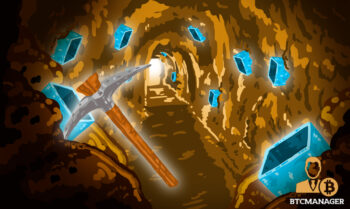2020-5-5 22:34 |
Today is a big day for Ethereum as it surpasses 10 million blocks. Unlike the Bitcoin network where it takes 10 minutes to produce one block, Ethereum blocks are mined every 20 seconds.
Big Day for #Ethereum ! Just passed 10M mined blocks!
— CoinMetrics.io (@coinmetrics) May 4, 2020
The digital asset Ether is also recording 57% returns YTD as currently, Ether trades at $205. Moreover, in the past 30 days, Tether paid $757,000 in fees for the processing of transactions on the Ethereum network.
Launched in 2015, Ethereum remains the second biggest network that will go through the PoW to PoS transition in the coming years.
The Ethereum 2.0 roadmap reveals that it will be launched as early as July 2020 but will be implemented in three phases — Phase 0 Beacon Chain which is the one coming by the end of Q2 2020 and will introduce staking.
Phase 2 that will make Eth 2.0 network operational after its introduction at some point in 2022 as Ethereum co-creator Vitalik Buterin recently said, Eth 2.0 issuance could take two years at most.
Back in mid-April, Prysmatic Labs launched Topaz testnet that requires a deposit of 32 ETH, the minimum requirement for staking as planned for Ether 2.0 mainnet.
We just saw the first lucky validator get to >1% returns staking on the Topaz testnet. Should see more cross the barrier soon! pic.twitter.com/3qZan7YYts
— vitalik.eth (@VitalikButerin) May 3, 2020
July launch is likely to be testnet…The initial launch of Ethereum 2.0 will most likely operate as a testnet network for the new proof of stake (PoS) consensus ecosystem. As such, most of the smart contracts and economic activity will remain on the original network which will exist parallel to Eth 2.0. Moreover, initially, Eth1 coins could be converted into Eth2 but not back.
The issuance rate of Eth2 will depend on the amount of Ether participating in the staking process. And the more ETH is transferred into Eth2, the more coins will be issued. But the more coins are staked the lower the investment return but also lower the annual inflation rate.
The entire economy of Eth 1.0 will be later transferred to new network Eth 2.0, a transition that is “risky, highly complex and will take a considerable amount of time,” noted BitMEX in its latest report.
For Ethereum’s growth to continue, both the full node operators and consensus agents would be required to run larger computers, this would not only become increasingly expensive but could “eventually lead to increased centralisation,” and degrade the censorship resistance characteristic of the system.
As for the much-anticipated sharding for scalability, it would be added to the system in phase 1 which has now been scaled down to just 64 from the original 1,024 shards.
The beacon chain, the parent chain will contain links to each shard. Also, in phase 1, the sharding system and staking process will become interrelated.
An incredibly ambitious project…According to BitMEX, because of constant experimenting with new and complex systems, Ethereum “satisfies a need in a community keen on trying new ideas.”
As such, a “considerable amount of funds will move into Ethereum 2.0 and earn the staking rewards, perhaps billions of dollars worth of ETH,” predicts BitMEX.
As for what will be the effect of the launch of Ethereum 2.0 on the price, in the short term, a significant amount of ETH will be locked inside the beacon chain attracted by taking which would “restrict the supply of ETH on the market and drive up the price.”
But at the same time, it could merely end up attracting ETH from other contracts where they are locked. But in order to drive long term value, Ethereum 2.0 needs to have sustainable demand as well.
However, before that, there is a lot to be done, the proof of stake and sharding need to work and be “compelling enough to attract the economically significant components of the Ethereum ecosystem over to it.” Moreover, smart contracts and DeFi systems would have to choose between the shards.
So, overall it will be “many years” before the Ethereum ecosystem makes the switch or at least a significant part of it. It said,
“Ethereum 2.0 is an incredibly ambitious project and we consider it highly unlikely that it will succeed as planned, without major hiccups.”
Ethereum (ETH) Live Price 1 ETH/USD =$207.7405 change ~ -1.26%Coin Market Cap
$23.02 Billion24 Hour Volume
$4.64 Billion24 Hour VWAP
$20324 Hour Change
$-2.6075 var single_widget_subscription = single_widget_subscription || []; single_widget_subscription.push("5~CCCAGG~ETH~USD"); origin »Advanced Internet Blocks (AIB) íà Currencies.ru
|
|















